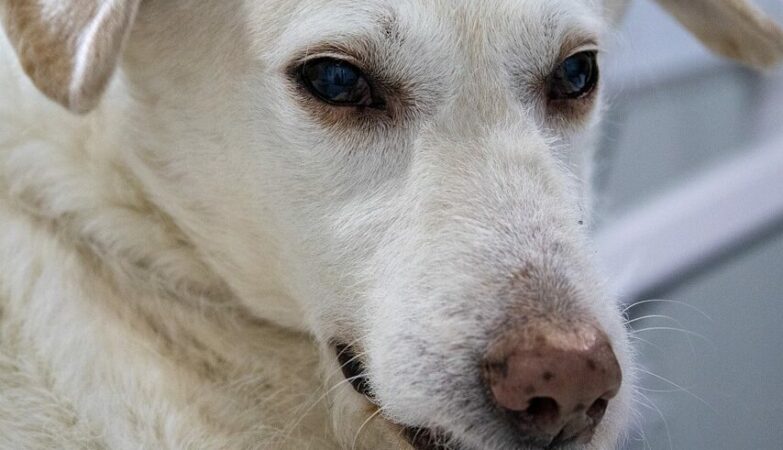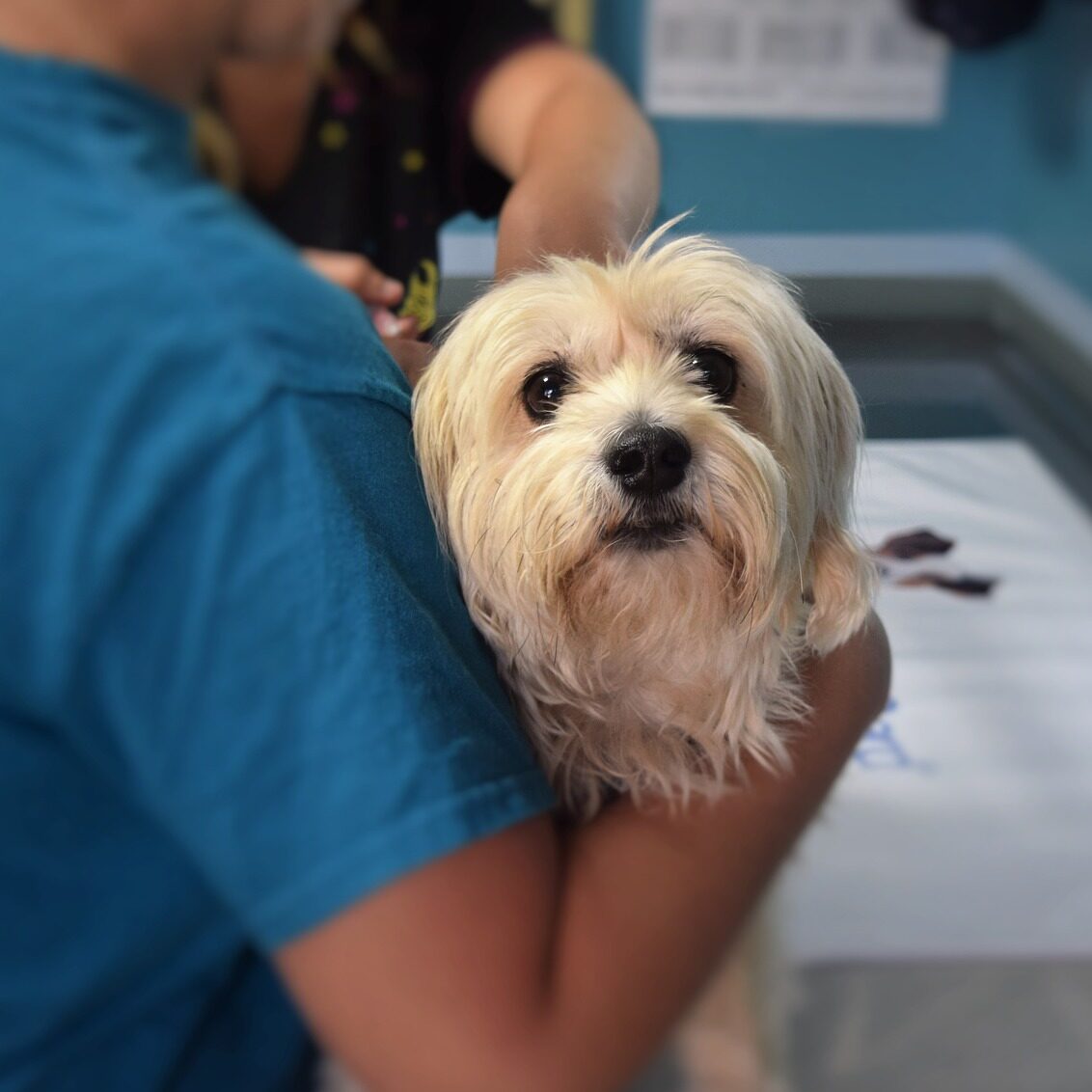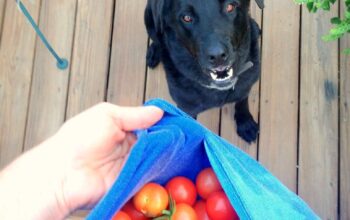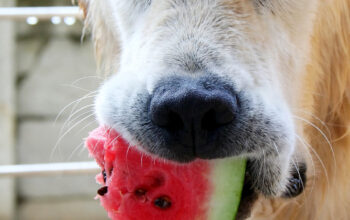How can you help a child go through the process of how to understand a dogs death?
I did that by talking to my child about what we were doing and what our family dog was going through – “It is time for Brewster’s medicine”, or “Mom has to take Brewster to the doctor today.” Even this tiny level of involvement gave my child a greater understanding of the situation, more compassion for Brewster and more patience to allow me to do what I needed for him.
The morning after our dog, Brewster, died, our 3-year-old daughter Brittany went over to his empty dog bed and waved her hand through the air as though stroking an imaginary dog. Then she took a little plate from her toys and brought it to the dog bed and explained that she was feeding Brewster.
Brittany sometimes creates imaginary versions of real things (we have our real vacuum and a evil vacuum that she likes to hide from). I was surprised to learn we had a evil Brewster, but it provided some comfort to both of us during a difficult period.
Brittany doesn’t understand life and death as a toddler yet. When children grow their understanding, their emotions also grow. Helping Brittany process Brewster’s death has been easy and difficult in some ways. She felt that the things had changed for our family and I tried to help her through Brewster’s death.
Initially I am not a parenting expert at all but I will share some of the things I did in the hope that it might help someone else in a similar situation.
The lead up to Brewster’s death
Before what I wrote above, Brewster had been sick for several months.
Brittany had seen me lift him into and out of the car, guide him through the house, take him outside more often, block the stairs so that he didn’t fall, and feed him by hand. She had been with grandparents while I took him to the vet and had been with me to the clinic several times to pick up medicine. She’d seen him vomit and fall and get trapped in corners.
We spoke about how Brewster was not feeling well. Sometimes I said he was unhappy or his stomach was unhappy because she understood “happy” and “bad” better than “well” and “unwell” and he needed extra care and attention and learned to be (a bit) patient.
Although she could not take care of him herself, I found that it helped to involve her in his care. I did that by talking to her about what we were doing and what he was going through – “It’s time for Brewster’s medicine.” Or “Mom has to take Brewster today to the doctor.” Even this small level of involvement gave her a greater understanding of the situation, more compassion for Brewster and more patience to allow me to do what I needed for him.
It also laid the groundwork for his death.
The day Brewster died
Brewster died at home. In preparation for his death I felt that Brittany could understand things a little better if she could see him and see the vet. But I did not want Brittany to see him die. I knew I wanted to be with Brewster and I knew I would be very upset about it. In that state, if she saw me and saw the vets Brewster inject would likely upset her. My mom came to care for Brittany so that I could concentrate on Brewster.
If we had had to take Brewster to the clinic for the procedure, I would not have taken Brittany with me. I would have given her the chance to pet him or say goodbye at home and found someone to stay with Brittany while I went with Brewster.
The death of a pet is extremely difficult. This situation adds another dimension to children. You know your children and yourself. Think about what you need and try to arrange things to help through this difficult time all together.
I explained Brittany that the doctor came to help Brewster but did not go into more detail than that.
I asked Brittany before he was euthanized if she would like to pet Brewster. She could sense that something unusual was happening and she reacted with a bit of uncertainty so she declined. She has never pushed to say goodbye or to pet Brewster.
My mother played with Brittany, while I stayed with Brewster. Brittany wanted to see me after he died — and i’d collected myself a bit — so my Mom took her over to us. Brittany was again reluctant to pet him even though eventually she did. I tried to explain that Brewster was too sick to be so anxiously awaiting the news. And the doctor could never make him better.
She saw Brewster in the vets car loaded and that became what she drew upon. I heard continuously for months, “Doctor had to take him”
The aftermath of the death
For Brittany it sank very quickly so quickly that Brewster was not home anymore. As she peeked in my room the first morning and saw Brewster’s empty bed, she said : “Doctor had to take him away.”
Right or wrongly I did not try to explain what it meant to be dead. I said he was too sick and he was no longer at home and he was not coming home. I tried to be clear that was not like the other times that I took him to the doctor and finally brought him home. Each time I said this she responded with “Doctor had to take him.”
We talked about how he was sick and unhappy and that the doctor could not make him better.
I put a picture of Brewster in her room to see and sometimes even pet him to it. It meant a lot for her.
Packing up some of Brewster’s items was a bit challenging for Brittany. She didn’t like it when his food bowls were no longer in their normal place. And she has tried the dog toys several times before I finally let some of them out of the house.
Talk about your dog!
Brittany talks all day about Brewster and still does. Her way of talking about him has changed. We no longer have a Brewster who needs to be fed and petted. But a fictional Brewster has started joining all her stuffed animals to have cuddles before bedtime.
Fast forward three months after Brewster died, Brittany woke up from a nap and said: “Brewster was sick with his stomach? Doctor had to take him? But he will come back! This was the first time she had spoken about him returning. When I said no, she lay down sad and a little bleary eyed.
Later that night she spoke again about him. “He is soft. He has an ugly nose. Eyes also. He smile at me. He was a good pet. Dog was good.” It was easy to agree with all of this and while I may have had a few tears she did not.
I think that talking about Brewster and interacting with an imaginary Brewster are healthy ways to help a toddler understand the death of a dog. Sadness is part of life so I hope to help Brittany learn how to deal with her feelings and experience her different emotions.
Toddlers are full of emotion and yet they don’t know how to express themselves. The death of their dog is a change in their life. They might have difficulty sleeping, appear grumpy or clingy as they adapt to their new family.
Patience, understanding, openness and love will help you all to find your way through the process.
Talk about the next dog in a pound

Brittany loves all animals but dogs particularly. As we talk about Brewster, other dogs we know and dogs in general, our conversations have shifted toward adopting another dog. Brittany has no idea of what it means to adopt a dog as two-year old.
But she’s made it clear that she wants to have a dog of her own again. She said: “We will get a new Brewster.”
I know Brittany will be excited when we find another dog and be very happy when she realizes that this is our dog. I’m not yet ready to bring a dog into our family as much as I want to give this experience to her.
I think it is lovely for now that she loves Brewster so much and that he was such an important part of her life that she thinks about our future dog in light of him.
The advice to help a tot understand the death of a dog
Please use language that your child understands. When explaining that Brewster was sick, often “unhappy” was replaced by “not feeling well.” If your dog is sick, bring your child into the care of your dog. While she may not be able to give medicine or go to the vet, talking about what you are doing and what needs your dog is a great way to help a toddler understand the death of a dog.
The death of your dog is hard and traumatic. Throughout this time, having to look after a toddler makes it harder. Whatever you are planning or unexpectedly at home or a clinic, seek help before, during and after so that you, your dog and your child can be nurtured.
Keep your explanations simple, consistent and truthful. Brewster was sick. The doctor couldn’t improve him. He is not home. Don’t lie and say your dog is going on a farm in the countryside (or somewhere else). Don’t try to explain what it means to be dead. As your child grows, you can start to explain the situation a little more fully.
A toddler may not grieve as much as you do. Your understanding of death and your relationship with your dog are different from your toddler’s. She will feel that things have changed and may react with sadness, anger or sleeplessness.



